
|
KKISS
|
 |

|
KKISS
|
 |
Comets, asteroids, Kuiper Belt objects (KBOs) and some moons of the major planets are considered among the most primordial bodies that survived widely unaltered from the formation period of our planetary system and that are still observable from Earth today. They represent the "memory" on the most original material and on physical conditions that prevailed during the formation of our solar system some 4.6 billion years ago.
|
|
Science Objectives |
|
|
The Team |
|
|
Related Links |
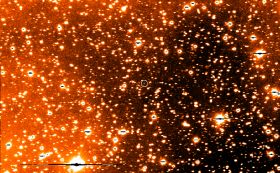 Figure 1: The Rosetta target comet 67P/Churyumov- Gerasimenko, observed with the FORS2 instrument at the 8.2m Antu telescope of the Very Large Telescope Observatory VLT of the European Southern Observatory ESO at Cerro Paranal in Chile. By the time of the observations the comet was at 5.6 AU solar and 4.6 AU Earth distance. The comet appears point-like and is mark by a circle close to the center of the image. Most objects seen in the images are background stars of the Milky Way.
Figure 1: The Rosetta target comet 67P/Churyumov- Gerasimenko, observed with the FORS2 instrument at the 8.2m Antu telescope of the Very Large Telescope Observatory VLT of the European Southern Observatory ESO at Cerro Paranal in Chile. By the time of the observations the comet was at 5.6 AU solar and 4.6 AU Earth distance. The comet appears point-like and is mark by a circle close to the center of the image. Most objects seen in the images are background stars of the Milky Way.
The research project aims at the characterization of the physical properties of these bodies, i.e. their sizes, shapes, albedo, temperatures, colours and surface composition as well as the production of gas and dust in case the bodies show activity like comets do. These physical parameters are determined from observations using optical 4-8m telescopes (
![]() Calar Alto,
Calar Alto,
![]() ESO La Silla,
ESO La Silla,
![]() ESO VLT,
ESO VLT,
![]() Rozhen,
Rozhen,
![]() La Palma
) and radio telescopes (
La Palma
) and radio telescopes (
![]() APEX,
APEX,
![]() SMT,
in the future also
SMT,
in the future also
![]() ALMA
) equipped with modern instruments for measurements in the visible, infrared and sub-/mm wavelength range. Furthermore, instrumentation onboard of Earth satellites (
ALMA
) equipped with modern instruments for measurements in the visible, infrared and sub-/mm wavelength range. Furthermore, instrumentation onboard of Earth satellites (
![]() Herschel,
Herschel,
![]() HST,
HST,
![]() Spitzer
) or airplanes (
Spitzer
) or airplanes (
![]() SOFIA
) are or will be used. Special attention is paid to target objects of space missions - like for instance
SOFIA
) are or will be used. Special attention is paid to target objects of space missions - like for instance
![]() Rosetta,
Rosetta,
![]() Dawn,
Dawn,
![]() Deep Impact,
Deep Impact,
![]() Stardust, and
Stardust, and
![]() New Horizons
-, in particular for missions with MPS share in the scientific spacecraft instrumentation.
New Horizons
-, in particular for missions with MPS share in the scientific spacecraft instrumentation.
This project continues along the line of research performed since 1983 by the MPAe/MPS project ![]() GBOC (Ground-Based Observations of Comets) under supervision and guidance of Prof. Klaus Jockers.
GBOC (Ground-Based Observations of Comets) under supervision and guidance of Prof. Klaus Jockers.
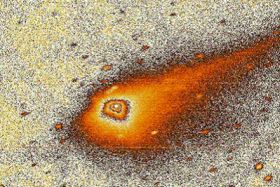 Figure 2: The Rosetta target comet 67P/Churyumov- Gerasimenko when active and surrounded by a coma of gas and dust. The brightness distribution in the coma is non-uniform. This indicates enhanced gas and dust production at various locations at the nucleus surface.
Figure 2: The Rosetta target comet 67P/Churyumov- Gerasimenko when active and surrounded by a coma of gas and dust. The brightness distribution in the coma is non-uniform. This indicates enhanced gas and dust production at various locations at the nucleus surface.
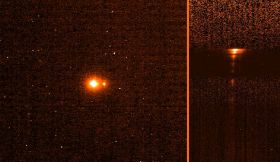 Figure 3: The dwarf planet binary Pluto-Charon (left panel, exposed in the near-infrared K band using the NACO instrument the Very Large Telescope Observatory VLT of the European Southern Observatory ESO at Cerro Paranal in Chile.. The near-infrared spectrum (right panel) of both KBOs displays prominent absorptions bands of various ices at the surface of the objects. The curvature of the spectra in J and H bands (upper part of the spectrum) is due to refraction of the infrared light in the atmosphere of the Earth.
Figure 3: The dwarf planet binary Pluto-Charon (left panel, exposed in the near-infrared K band using the NACO instrument the Very Large Telescope Observatory VLT of the European Southern Observatory ESO at Cerro Paranal in Chile.. The near-infrared spectrum (right panel) of both KBOs displays prominent absorptions bands of various ices at the surface of the objects. The curvature of the spectra in J and H bands (upper part of the spectrum) is due to refraction of the infrared light in the atmosphere of the Earth.
The following observing projects are currently performed:
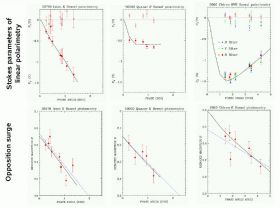 Figure 4: Linear polarization and opposition brightening of Kuiper Belt objects for different phase angles Sun-object-observer. Model calculations of the measurements indicate that at least two different materials exist at the surface of the bodies.
Figure 4: Linear polarization and opposition brightening of Kuiper Belt objects for different phase angles Sun-object-observer. Model calculations of the measurements indicate that at least two different materials exist at the surface of the bodies.
| MPS scientists working on these projects | |
|---|---|
| Hermann Böhnhardt | All observing projects using optical telescopes, Herschel, Spitzer, Sofia, HST |
| Paul Hartogh | All observing projects using sub-/mm telescopes, Herschel, Sofia |
| Manuela Lippi | High dispersion near-IR spectroscopy of comets |
| Chemeda Ejeta | Polarimetry of small body surfaces |
| Christopher Jarchow | Observing projects using sub-/mm teleskopes, Herschel, Sofia |
| Andreas Nathues | Observing projects on asteroids |
| Silvia Protopapa | Pluto-Charon, Triton and Kuiper Belt objects, Herschel |
| Miriam Rengel | Observing projects using sub-/mm teleskopes, Herschel, Sofia |
| Juan Sanchez | Observing projects on asteroids |
| Cecilia Tubiana | Rosetta target comet 67P/Churyumov-Gerasimenko |
| Jean-Baptiste Vincent | Dust comae of comets |
| Collaborating scientists at other research institutes | |
| Jessica Agarwal | Noordwijk |
| Stefano Bagnulo | Armagh |
| Luis Barrera | Santiago de Chile |
| Antonella Barucci | Paris |
| Tanyu Bonev | Sofia |
| Dale Cruikshank | Moffett Field |
| Elisabetta Dotto | Rome |
| Mike Gaffey | Cambridge |
| Will Grundy | Flagstaff |
| Olivier Hainaut | Garching |
| Ulli Käufl | Garching |
| Ludmilla Kolokolova | College Park |
| Luisa Lara | Granada |
| Emmanuel Lellouch | Paris |
| Javier Licandro | La Palma |
| Karen Meech | Honolulu |
| Karri Muinonen | Helsinki |
| Thomas Müller | Garching |
| Mike Mumma | Greenbelt |
| Jose-Luis Ortiz | Granada |
| Dina Prialnik | Tel Aviv |
| John Stansberry | Tucson |
| GianPaolo Tozzi | Florence |
| Diane Wooden | Moffett Field |
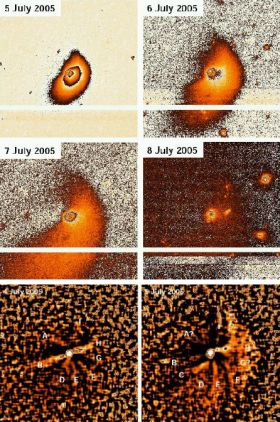 Figure 5: The DeepImpact event at comet 9P/Tempel 1 in 2005. The 4 panels in the upper part show the expansion of the ejecta cloud produced by the space probe impact at the comet. The coma light from normal activity of the nucleus was removed by image processing techniques. The pair of images at the bottom shows linear structures of dust (marked with letters A, B, C, D, E, F, G, H, I) in the cometary coma that are caused by continuous normal activity from areas of enhanced dust emission at the nucleus surface. On 5 July 2007 the ejecta cloud from the DeepImpact event is superposed to the normal activity of the comet.
Figure 5: The DeepImpact event at comet 9P/Tempel 1 in 2005. The 4 panels in the upper part show the expansion of the ejecta cloud produced by the space probe impact at the comet. The coma light from normal activity of the nucleus was removed by image processing techniques. The pair of images at the bottom shows linear structures of dust (marked with letters A, B, C, D, E, F, G, H, I) in the cometary coma that are caused by continuous normal activity from areas of enhanced dust emission at the nucleus surface. On 5 July 2007 the ejecta cloud from the DeepImpact event is superposed to the normal activity of the comet.
|
GBOC Homepage at MPS |
| © 2009, Max Planck Institute for Solar System Research, Lindau |
Böhnhardt 23-09-2009 |